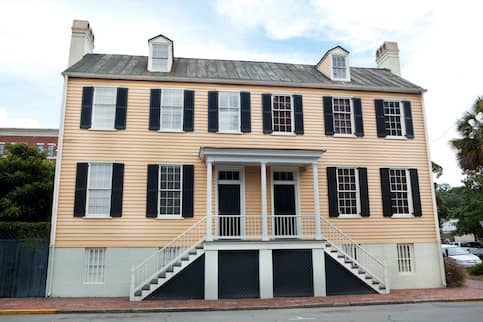Have you wondered, ‘what is a 15-year fixed mortgage?’ Maybe you’ve dreamt of owning your house faster or wondered what it would feel like not to have a mortgage payment.
A 15-year mortgage can help you achieve these goals, but it’s a loan reserved for specific borrowers. The higher monthly payments on the home loan are something everyone should consider and evaluate their situation to ensure it’s a good fit.
What Is A 15-Year Fixed Mortgage?
A 15-year fixed mortgage is a home loan with a fixed interest rate for the life of the loan. As a result, homeowners pay the same principal and interest payment amount each month, unlike an adjustable-rate mortgage whose interest rate could change annually, drastically changing a borrower’s monthly payment.
With a fixed rate mortgage, you pay principal and interest at a set rate. As the name suggests, the interest rate doesn’t change for the loan term. Instead, you lock in your interest rate before you close on the loan, and that’s the rate you pay until you pay the loan off or refinance it.
Keep in mind, you might have to also pay mortgage insurance if you don’t put down at least 20% on the home. The good news is, though, Fannie Mae allows lenders to cancel the Private Mortgage Insurance once borrowers owe less than 80% of the home’s value.
The 15-year loan opens up more opportunities to invest money elsewhere once you own your home. Still, only around 30% of homebuyers choose this option because it’s often misunderstood and most people think they can’t afford it.
See What You Qualify For
Buy A Home
Discover mortgage options that fit your unique financial needs.

Refinance
Refinance your mortgage to have more money for what matters.
Tap Into Equity
Use your home’s equity and unlock cash to achieve your goals.
How Do 15-Year Fixed-Rate Mortgages Work?
15-year fixed rate mortgages have a 15-year term, meaning you pay the principal (the amount you borrowed) off in 15 years. The loan amount is amortized over 180 months based on the interest rate. As you pay the loan balance down, your interest charges decrease, which means a larger portion of your loan payment covers principal versus interest.
To get a 15-year fixed-rate mortgage, you first apply for the mortgage, stating that you would like a 15-year loan. Next, your application will go through underwriting along with your qualifying documentation, such as your paystubs, W-2s, tax returns and asset statements to prove you have the money for the down payment and can afford the loan.
If approved, you are ready to lock in an interest rate. When you lock your rate, you’re securing the rate for the life of the loan. Underwriters use this rate to determine your monthly payments and amortization table so that your loan is paid off in 15 years.
15-year rates are often lower than 30-year fixed rates because it poses a lower risk to lenders. The less time you borrow money for, the less risk of default you pose. You’ll likely have better opportunities for lower interest rates because you’re paying the loan off in half the time of a 30-year mortgage.
Pros and Cons Of 15-Year Fixed Mortgages
Like any mortgage, there are pros and cons of a 15-year fixed mortgage that you should understand to make sure it’s right for you.
Pro: Pay Less Interest Overall
Because the 15-year fixed rate mortgage is paid off in half the time of a 30-year mortgage, you’ll pay much less interest. The shorter your term is, the less time you have to pay interest. The same loan amount over a 30-year term will have much higher interest payments than over the shorter period of 15 years.
Pro: Lower Interest Rates
15-year loans are much less risky for lenders, which means they offer lower rates and fees on your loan. Lenders charge rates and fees based on the likelihood that you’ll be able to pay the loan back on time. If you’re a higher risk of default, you might pay higher origination fees to cover the risk.
To get a lower interest rate, not only should you apply for a 15-year mortgage versus a 30-year, but you should present as many ‘good’ qualifying factors as possible, such as good credit, a low amount of debt and a stable income.
Pro: Builds Home Equity Quicker
With a 15-year mortgage, you build home equity much faster. Home equity is the difference between the home’s value and your outstanding mortgage. For example, if the home is worth $200,000 and you owe $100,000, your home equity is $100,000.
If you sold the house today, you’d walk away with $100,000, not taking into consideration any fees. The key with a 15-year mortgage is that you build the equity faster because you have half the time to pay the loan off, so your payments are much heavier in principal versus interest, so you build equity faster.
Con: Larger Monthly Payments
Higher monthly payments are a downside of the 15-year loan. Again, because you have half the time to pay the loan off, your principal payments are much higher, and then there’s still the interest you owe on the loan.
For example, let’s say you borrow $100,000 at 3.5%. We’ll use the same interest rate for this situation so you can see the difference in payments.
On a 30-year loan, your payment would be $449.04, not including insurance or taxes. On a 15-year loan, it would be $714.88. So before you take the higher monthly mortgage payment, you must make sure you can comfortably afford it for the next 15 years.
Con: Less Affordability
It can be harder to afford a higher-priced home when you have to commit such a large amount to your monthly payments. Your debt-to-income (DTI) ratio could hold you back from being able to afford a much higher loan amount.
If you were to choose a 30-year mortgage instead of a 15-year loan, you’d have more time to stretch the payments out. This results in lower monthly payments and more room in your debt-to-income ratio for a higher loan for your home purchase.
Con: Can Make Saving Money Harder
If you take the higher monthly payment, you could have less disposable income to reach other personal financial goals such as saving for retirement, an emergency fund or other essential investments.
When a large portion of your income is committed to the mortgage payment, it takes away other options to improve your financial situation, which could have ramifications on your future financial self.
Find A Mortgage Today and Lock In Your Rate!
Get matched with a lender that will work for your financial situation.
Current 15-Year Fixed Mortgage Rates
Today’s current mortgage rates are up slightly from what we’ve seen lately, but they’re still low considering all factors. Since a 15-year fixed mortgage rate can change daily, it’s important to watch rates when you’re ready to buy a home or refinance and to be prepared to lock in the rate you desire when it becomes available.
The economy, politics, the stock market and unpredictable factors (like COVID-19) can all significantly impact 15- and 30-year mortgage rates. So, if you have your eye on a 15-year mortgage, be ready to lock in the rate and get your loan closed to secure the best rate for your loan.
Should I Refinance To A 15-Year Fixed-Rate Mortgage?
Suppose you already own a home but have a 30-year fixed-rate mortgage or an adjustable-rate mortgage. In that case, you might consider refinancing into a shorter term, especially while interest rates are low.
Refinancing to a 15-year loan can be an excellent idea for some, but it doesn’t make sense for everyone.
Here are some situations you should consider refinancing into a 15-year loan.
You’ve Maxed Out Your Retirement Savings
If you’ve maxed out your retirement contributions and know you can continue to do so each year and still have extra money, refinancing to a 15-year loan might make sense. You’ll use up your free capital by paying your mortgage down faster and paying less interest. In the end, you’ll have more money at your disposal because you’ll have more equity in the home much quicker.
You Can Commit To The Higher Payment
If you know you have the room to commit to the higher payment, refinancing into a 15-year loan can make sense. You’ll secure the lower interest rate that 15-year loans offer, and you’ll pay the loan off in half the time.
You Care About Building Equity
If building home equity fast is a concern for you, the 15-year mortgage will help you build equity faster. You’ll pay more principal toward the loan each month, which allows you to own the home much faster. The 30-year term offers a slow and steady pace with a more affordable payment, but it takes longer to see equity in the home.
On the other hand, just because you care about building equity doesn’t mean you have the resources to do it rapidly. Here are some reasons to not refinance to a 15-year loan.
You Don’t Have the Capital To Tie Up
If you would be sacrificing other investments or financial goals just to own your home faster, don’t do it. You’ll have to commit a much more significant portion of your income each month to your mortgage payment. If that means you can’t invest in your retirement or other financial goals, don’t refinance.
Your Job Isn’t Stable
If your job is on the rocks or you aren’t sure if you or your spouse will continue in the career you’re in, don’t make a major change like refinancing to a 15-year loan. Keep your 30-year loan and if you have the money to make a 15-year payment, do it, but if you don’t, you won’t be penalized for making the 30-year payment that you know you can afford.
15-Year Fixed Mortgage FAQs
What is the difference between a 15-year fixed mortgage and a 30-year fixed mortgage?
The main difference between a 15-year fixed mortgage and a 30-year fixed mortgage is the time you have to pay the loan off in full. A 15-year term gives you 15 years, whereas a 30-year term gives you double that amount of time.
Other differences include the interest rates charged (15-year loans have lower rates) and the amount of principal you pay each month. For example, with a 15-year loan, you’ll pay much more principal each month than you would with a 30-year loan.
How do I qualify for a 15-year fixed-rate mortgage?
To qualify for a 15-year fixed-rate mortgage, you’ll need great credit and a low debt-to-income ratio. In addition, because you’ll pay the loan off much faster, you need a better credit score and DTI than you would for a 30-year loan because the risk of default is much higher.
You must prove that you are at low risk of default and can afford the mortgage payment beyond a reasonable doubt. A credit score of 700 and a debt-to-income ratio of around 36% are usually required to secure a 15-year loan.
Is a 15-year loan best for me?
If you’re in a good financial situation and can comfortably afford the 15-year payment, it can be best for you because you’ll pay the least amount of interest on the loan. The faster you pay the loan off, the less interest you pay.
Sometimes, though, the 15-year loan isn’t the right option. If you still want to pay your loan off fast, consider making extra payments toward your principal on a 30-year term. This way you can make additional payments when you can, but you aren’t on the hook for them if you can’t afford it.
You can also consider putting all windfalls, such as a tax refund or work bonus, toward your principal rather than spending it. As a result, you knock your principal down faster and will own your home in less than 30 years.
The Bottom Line
If you’ve wondered what a 15-year fixed mortgage is, you might consider this shorter term loan to build equity in your home faster, save money on interest and own the home in half the time.
View Your Refinancing Options
See recommended refinance options and customize them to fit your budget.

Sam Hawrylack
Samantha Hawrylack is a full-time personal finance and real estate writer with five years of experience. She has a bachelor's degree in finance and an MBA from West Chester University. She writes for publications like BiggerPockets, Angi, Well Kept Wallet, Crediful, Clever Girl Finance, AllCards, InvestingAnswers and many more.












